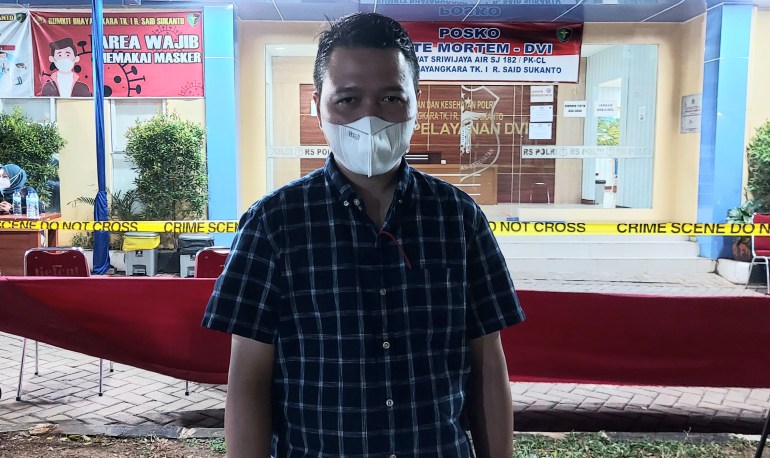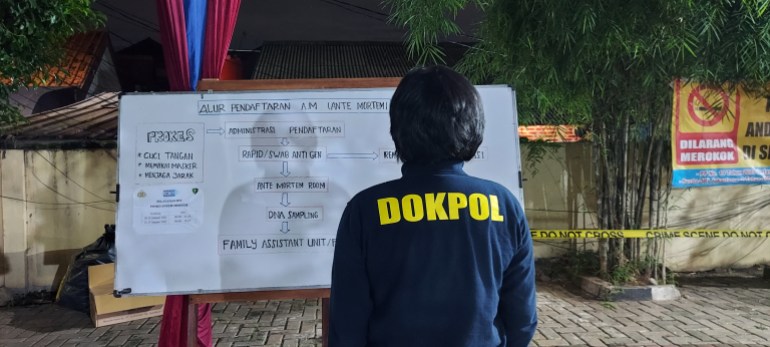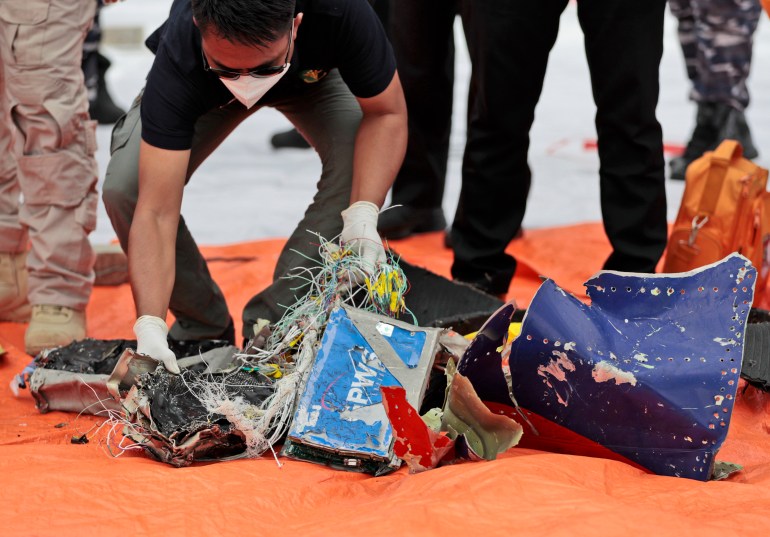Indonesia’s struggle to identify the Sriwijaya plane crash dead
DVI teams work closely with families of those on board to identify the remains recovered from the sea.

Jakarta, Indonesia – Yudi Qurbani has spent the last few days in an unexpected and unwanted role.
He has become the family representative at the Disaster Victim Identification (DVI) centre at Kramat Jati Police Hospital in Jakarta, coordinating with the team trying to locate the five members of his family who were on the Sriwijaya Air flight SJ182 that crashed into the Java Sea en route from Jakarta to Pontianak in Kalimantan on 9 January.
Keep reading
list of 4 itemsFamilies, friends of Indonesia plane crash passengers await news
Indonesia searchers locate black box recorders in crashed plane
Missing Indonesian plane feared crashed as debris found
“We know that there is a very small chance they will be found alive now, so our final hope is that we can get their bodies or body parts back for burial,” he told Al Jazeera.
The authorities have identified four victims from the crash including a member of the cabin crew but the identification process has been hampered by the condition of many of the bodies. In addition to finding one of the flight recorders known as a “black box”, Indonesian search-and-rescue teams have also found wreckage of the plane, intact corpses and “body parts”.
The five members of Qurbani’s family who were on the plane were his aunt and uncle, Rahmawati and Toni Ismail, his cousin Ratih Windania and her four-year-old daughter Yumna Fani Syatuzahr, and his nephew Athar Rizki Riawan, eight, with whom he was particularly close.

The extended family had been on a trip to visit other relatives in Bandung and Jakarta over the New Year holiday. Athar’s parents (Qurbani’s sister and brother-in-law) had stayed behind in Pontianak.
“As a family, we will be happy if the bodies can be found so that we can bury them, even if it is a small hope. I would like to see them if they are found, but I think it would be better if the parents did not. I would like to see them so that I can be sure,” said Qurbani.
According to Dr Richard Bassed, Senior Forensic Odontologist at the Victorian Institute of Forensic Medicine and Head of the Department of Forensic Medicine at Monash University, the Interpol standard DVI process consists of five phases including body recovery at the scene, mortuary examination, postmortem collection of data from living relatives, reconciliation and debriefing. “The time taken is greatly variable depending on the individual circumstances of the tragedy,” he told Al Jazeera.
“It depends on body condition, location, availability of forensic experts, logistics and funding. One thing to note is that Interpol states that under no circumstances is visual recognition to be used to confirm identity as too many errors have been made in the past.”
Painstaking process
Part of the postmortem team at Kramat Jati Police Hospital, Dr Laura, who prefers not to share her full name, is in charge of collecting all available data from the families that may help to identify their loved ones. This includes dental records, fingerprints, medical records, DNA samples from blood and mouth swabs and descriptions of any identifying features such as scars or tattoos.

“Basically we use anything and everything to identify people,” she told Al Jazeera. “This includes things that we may find with the bodies such as identification documents in wallets or pockets. We are working as fast as we can with the information that we have available. We hope that this will be over as quickly as possible.”
Dr Laura declined to say what body parts had been found at the crash site, but Dr Bassed told Al Jazeera that the term can refer to “large pieces like limbs all the way down to fragments of bone and flesh,” and that “body parts create a huge number of issues in trying to match individual pieces to one individual. The only way to be absolutely certain is to use DNA, which is expensive and time-consuming.”
Dr Bassed added that the condition of the bodies depends on many factors including whether the plane was on fire and the speed at which it was travelling.
Qurbani’s family is acutely aware of what that might mean.
“The DVI team has not told us what body parts they have found from the crash yet. But we have seen the pieces of the plane that have been recovered, so logically the bodies must be in the same condition. We think it will be hard to find bodies that are intact,” said Qurbani.

Perhaps because of Indonesia’s poor aviation record and frequent natural disasters such as tsunamis and other events such as fires, Indonesian DVI teams are no stranger to trying to identify victims in difficult circumstances.
Pressure for results
Dr Bassed has worked with Indonesian DVI teams in both mass fatality events and training and told Al Jazeera that they are well-trained and well-prepared.
“They came to Australia and assisted us during the Black Saturday bushfires in 2009 and were extremely helpful,” he said.
“The main problem is the insistence of the community, politicians and relatives that IDs be completed rapidly, which often means that visual ID and other less robust means are used and so mistakes can be made. This is not specific to Indonesia, but to many countries.”
For his part, Qurbani says that he is just focused on the search and identification process for now and agrees that the authorities need time to find the reason for the crash and reunite families with their loved ones. In the meantime, however, his mind frequently returns to his last few days with Athar, who stayed at his house for two weeks before the flight and spent time playing with his cousins.
“I was going to drive him to the airport, but I had to take my children to a doctor’s appointment. I feel that if I knew what was going to happen, I would have done my best to make him as happy as possible. He was so cheerful and so much fun. He made everyone around him happy and lifted the atmosphere wherever he went.
“I still can’t wrap my mind around this situation,” he said. “It’s like he’s still here, in my house, like a shadow.”